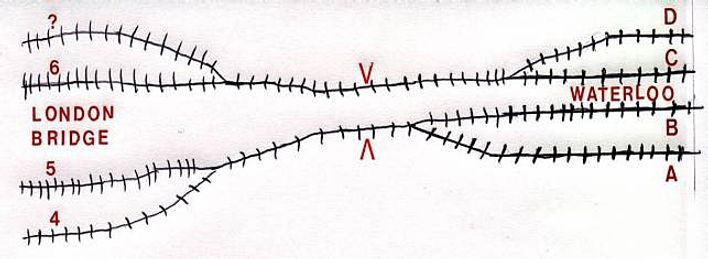The Rail
Bottleneck!
A second update of the article that first appeared in the 1994 edition of the TRUTH!
Sometime in the mid-late 1970’s of the previous century and, more notably, again this, the rail network out of Charring Cross wasted £millions of pounds while contemptuously disrupting train journeys for commuters with as much success as King Kanute turning back the tide. Admittedly, the tide ebbed as it always does, while there was no such chance for the rail network, which very much fought a losing battle, and with itself!
t
Ever since Charring Cross, Waterloo and London Bridge train stations were in service, there has and will continue to be a slow down between London bridge and Waterloo, and so far, despite the two lots of attempts to improve it, the key point remains to be addressed and, more to the point, resolved.
As mentioned at the start, the problem of the bottleneck outside London Bridge was one of the articles printed in one of the three issues of the TRUTH as long ago as 1994. 26 years ago. With personal computers and the internet, the TRUTH updated the original article with a coloured image of the original drawing in 2000:

Before the work was carried out in the mid-late 1970’s, ‘?’ above left was platform 7. After the work was completed, what had been platform 7’s line became a supposed fast line into Waterloo, one that, for obvious reasons, did not stop at London Bridge. It’s worth keeping that point in mind, along with the fact that it had priority over trains waiting at platform 6 which also go to Waterloo. For some reason, platform 5 is reversible. That means, trains stopping on that platform travel towards Waterloo or, in the opposite direction, away from the city and central London as do trains which stop at platform 4. On the right side of the diagram are the 4 platforms at Waterloo, with D & B for trains going to Charring Cross and A & C for trains leaving Charring Cross. As you will note from the diagram above, there are, in effect, 4 active lines at both London Bridge and Waterloo; however these lines are “Bottlenecked” from 4 down to just 2 lines, which means that, although there are 4 lines of train track at each end, only 2 trains can use them at any one time…! Realistically speaking, there only needs to be 2 lines at London Bridge and 2 at Waterloo for all the good the two lots of unnecessary, costly work there was and at the rail commuters expense
In conclusion. The only way the bottleneck situation can and will ever be resolved, is to demolish the buildings on either side of it and expand the bridges. An unlikely occurrence, and something to keep in mind the next time the rail network causes the same, unnecessary disruption to the network services in and out of Charring Cross!
Let the train take the strain!
Back in 2000, the TRUTH added the following to the above article:
Note to 2 Jag’s Deputy PM John Prescott: Expecting car owners to leave their car’s at home and travel to work on a unreliable, chaotic train service (one of who, Connex, has lost their franchise) without improving the service first, is a bit like Building Canary Warf and not bothering to extend an Underground service to it! Then again, Mr Prescott also thinks that car commuters, especially those from rural areas that have no local train station (what were the town developers thinking of!) enjoy getting up at the crack of dawn (6/7am), and, as a result of (long) traffic jams, taking some 2 hours to drive into work! (That, by the way, is 20 hours a week they won’t get back.)
The solution to this problem is oh so ‘Childishly’ simple, as anyone who has ever had a train-set as a CHILD will know!
As indicated, above, some towns and areas do not have a local train station. What they do have, however, is a Railway network close by. That being the case, all that is needed is to construct some “Railway Halt’s”, which are small rural stations to which people can make a short car journey, and, if possible, by their partner, so there is no need to leave the car at the station.
Two profound examples of common sense more than logic, as you’ll surely agree.

Contact us: the.irrefutable.truth2020@gmail.com